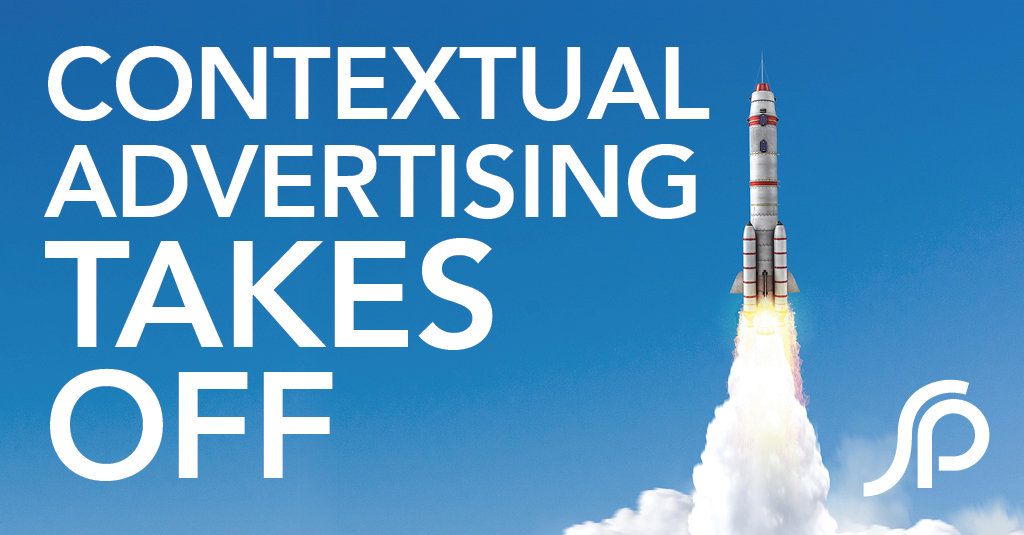Contextual Advertising Takes Off

Behavioral advertising, third-party cookies, and other intrusive ad strategies are out. Contextual advertising is very much in. How can you maximize the benefits of this strategy? If you’re ready to dive into the world of contextual advertising, here’s what you need to know.
It Looks Like It Sounds
Contextual advertising is one of those terms that sounds exactly like what it represents. It’s a digital marketing technique that aims to coordinate the ads shown on a webpage with the content of the page or the overall purpose of the site.
The advertising algorithms scan pages, processing information about keywords, images, and other information in order to determine what the page is about. They make “if this, then that” judgments about what might interest potential visitors. Then, the contextual advertising program returns and displays ads that “match” according to its interpretation of the page content. Think furniture ads being displayed on a site about home décor, ads for cookware showing up on a food blog, and so on.
The idea behind contextual advertising is to target potential buyers based on the content they choose to consume in the moment, making assumptions about associated keywords and products. Unlike cookie-based advertising, which was based on reacting to user behavior, this approach asks you to anticipate possible match points for future actions.
Why Should I Use Contextual Advertising?
There are many benefits to contextual advertising, but by far the biggest is the respect for user privacy. Instead of collecting data about the user and tracking them on (or even between) websites, to deliver ads, it bases advertising on the content of the page itself, assuming user interest is determined by logic.
In an era where more people than ever are concerned with their online privacy, sites that can assure users that their data isn’t being used to “spy” on them to sell them things will have a reputational advantage. According to a study by the Pew Research Center, “72% of people feel that almost all of what they do online is being tracked by advertisers, technology firms or other companies, and 81% say that the potential risks they face because of data collection outweigh the benefits.”
As privacy concerns force marketers to retire cookie-based advertising and find fresh solutions, techniques like contextual advertising can fill the gap and provide revenue-producing results. “A return to a contextual advertising model can indeed be a good fix for advertisers when the privacy concerns are limiting the mechanics of some digital advertising tools. Unlike behavioral targeting, contextual advertising doesn’t rely on third-party cookies to deliver relevant experiences. The proven model protects privacy, serves relevant ads and can have a phenomenal impact,” says one Forbes analysis.
On top of privacy perks, contextual advertising is just good for user experience overall. These ads tend to feel less intrusive than other types of advertising, since it thematically blends into the existing content on the page. Similarly, it makes sense that these ads are likely to be successful because they are directly linked to a potential customer’s interests.
Does Contextual Advertising Work?
For marketers used to using other, more tracking-heavy types of advertising, the idea of switching to contextual ads may cause concerns over whether it will be cost-effective. In reality, it may have advantages that other advertising strategies do not.
According to Digiday, 45% of surveyed marketers say that behavioral advertising (the “intrusive” ads that track users, rather than websites or pages) has not produced notable benefit, while 23% say it has actually caused ad revenue to decline. Combined with rising concerns over digital privacy, contextual advertising is a smart option for companies who want to make a positive user impression while getting real results.
Contextual advertising is also much more personal – a plus in today’s digital world. As IBM explains, “The deep analysis provided by AI is like what a human brain would do when deciding where to place an ad manually, which helps ensure your ad placement is relevant, timely, and of interest to the user. This also creates a more personalized experience for consumers, which is becoming increasingly important to consumers when deciding what brands they want to align with.”
Things to Keep in Mind
Because contextual advertising is keyword-based, you want to know how to avoid awkward algorithmic moments. Forbes recommends the use of “negative” keywords or exclusions to keep your ads off of sites and pages you don’t want to advertise on, even if the keywords seem to match. Whether that’s a whole site that you want to avoid, or just an algorithmic nightmare (Forbes uses the example of an artisanal knife ad showing up on a story about a violent crime), marketers need to be aware of potential stumbles.
Contextual advertising can tie into the personalization trend as well, all without being invasive. It can connect to the consumer’s desire for a more personal experience while also embracing the push for better privacy and data standards, which improves trust and reputation.
Consider contextual advertising as a creative challenge. It may require a little more in-depth consideration, but it is also an excellent way to build a more flexible advertising strategy. With a bit of creativity and thought, it can be a strategy that redefines your advertising program and offers a competitive advantage in your market.
Share
